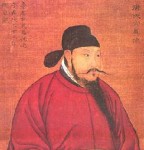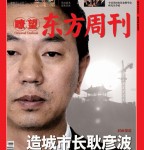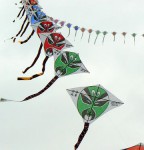There are different writing styles, or scripts written by hand in the Chinese language. The breakdown in style is roughly as follows: zhenshu (regular script prevalent in the Han Dynasty), caoshu (cursive script), lishu (official script) and zhuan-shu (seal character script). Chronologically, script style has experienced three epochs in the course of its over four thousand years bf history.
The three epochs are marked by three different scripts that came into fashion: seal character script, official script and regular script. The seal character period ran from the end of primitive society to the Qin Dynasty (221-206B.C). The period, lasting more than two thousand years, is divided into three phases: early seal character, greater seal character and lesser seal character.
Early seal characters are characters written by primitive people, being the earliest form of writing on record. The inscription on the pottery vessel in Dinggong Village is an example of this. It has a mild style and assumes varied postures. The characters look like a length of knotted rope. This form of writing was perhaps related to the use of rope by primitive people to record events. However, this point needs investigation.
Greater seal characters generally refer to ancient scripts of pre-Qin Dynasty, such as inscriptions on bones, tortoise shells, bronze vessels and drum-shaped stone blocks and the ancient language of the Six States.
Inscriptions engraved on bones and tortoise shells belong to the ancient language of the Shang and Zhou dynasties. Seal characters' feature is that strokes are carved in the round; however, the seal characters in inscriptions on bones and tortoise shells are mostly stiff and straight, because it is not easy to make a turn with the cutting edge of the tool in engraving. If we compare inscriptions on bronze vessels or hand script with inscriptions on bones and tortoise shells of the same period, we shall find that inscriptions en bones and tortoise shells have the attributes of the greater seal character script.
Early inscriptions on bronze vessels were first engraved on a clay mold and later cast on the bronze. Since it was easy to engrave on clay, the brush strokes showed roundness, fullness and roundabout turns. These features have been preserved to this day in vivid forms. Inscriptions on bronze vessels of later periods were engraved directly on the bronze with sharp knives or chisels. The characters became decorative, known as suspended-stitch seal characters.
Inscriptions on drum-shaped stone blocks were discovered in the early Tang Dynasty (around the year 618) in Shaanxi Province. The inscriptions were written in language of the pre-Qin period. They are famous works of calligraphy belonging to the period preceeding the Qin Dynasty and are in the collection of the Palace Museum in Beijing. Scripts of the pre-Qin period also include the ancient language of the Six States. They are all classified as greater seal character scripts.
Lesser seal character script was the officially approved script following the unification of Chinese languages by the Qin Dynasty. It is also known as Qin seal character script. Since it contrasts with the previous seal character script, the two are called greater and lesser. The Qin Dynasty used lesser seal character script to engrave inscriptions on stones extolling the merits of persons or things, to engrave seals or marks of authenticity or emblems or to write imperial edicts. It replaced greater seal character script, marking tremendous historical progress. For a country the size of China, where dialects are more numerous than in the various countries of Europe, a unified written language plays an important part as a link between various nationalities to cement national solidarity and achieve national unification. It was the Qin, or lesser, seal character script that served as a link and deserves much credit.
An outstanding work representative of Qin seal calligraphy is the writing of Li Si (?-c 208 B.C.), regarded as the father of lesser seal character script. He exerted a profound influence on the seal character script of later generations.
Different Chinese Calligraphy Scripts
Jia Gu Wen.
These refer to the scripts carved by the ancients of the Shang Dynasty (2100 B.C.-1600 B.C.) on tortoise shells and ox scapulas (shoulder blades), which are considered to be the earliest written language of China. Their discovery was by accident.
In 1899, Wang Yirong, an official under the Qing Dynasty, fell ill. One of the medicaments prescribed by the physician was called "longgu" (dragon bones). They turned out to be fragments of tortoise shells which were found to bear strange carved-on patterns. He kept the "dragon bones" and showed them to scholars who, after careful study, came to the conclusion that the carvings were written records from 3,000 years before and were of great historical significance. Further inquiries revealed that the "dragon bones" had been unearthed at Xiaotun Village, Anyang County, Henan Province, site of the remains of the Shang Dynasty capital.
Further digs made at the site in later years brought to light a total of more than 100,000 pieces of bones and shells all carved with words. About 4,500 different characters have been counted, and 1,700 of them deciphered.
Three thousand five hundred years ago, Anyang was a marshy area teeming with tortoises, a favourite food of the local inhabitants. And the Shangs were a very superstitious people. Their rulers would resort to divination and ask the gods for revelation whenever there was a gale, downpour, thunderstorm, famine or epidemic. Before going on a war or a big hunt, they would still more want to divine the outcome.
The method of divination then was to drill a hole on the interior side of the tortoise hell and put the shell on a fire to see what cracks would appear on the obverse side. By interpreting the cracks the soothsayer predicted the outcome of an event. After each divination, the dates, the events and the results would be written down and carved on tortoise shells or bones. And the collection of these became the earliest recorded historical material in China, from which modern scholars have divined "how things were in the Shang society".
In the oracle inscriptions, one finds many pictographs in their primitive picture forms, for example, for the sun, for the cow, and so on. Together they show that a well-structured script with a complete system of written signs was already formed in that early age.
Later on, the area around Anyang became dry, and tortoises grew scarce, so people began to use bamboo strips instead for divination. From this grew the practice of asking the gods about the future by drawing bamboo sticks, as one may see today at certain temples--a practice that has its remote root in the superstition of the Shang people.
Zhou Wen.
According the literature, Shi Zhou of Zhou Xuan Wang (827 B.C.- 782 B.C.) created Zhou Wen. Zhou is his name.
Jin Wen.
Jin Wen is the scripts carved on bronze wares during Shang (2100 B.C.-1600 B.C.) and Zhou dynasty (1600 B.C.- 221 B.C.).
Da Zhuan.
Usually by Da Zhuan we mean Zhou Wen or Jin Wen. At that period, there's no standard for scripts yet. Almost all piece we still have is in different scripts. We call all of these scripts Da Zhuan.
Xiao Zhuan.
Qin Shi Huang defeated all other countries in China in 221 B.C. Then he made a standard of the scripts. The scripts at that time is called Xiao Zhuan.
Zhuan Shu(seal script).
Actually, we call all of the scripts before and include Xiao Zhuan. But sometimes, some people call Da Zhuan and Xiao Zhuan as Zhuan Shu.
Li Shu.
Although Xiao Zhuan is the official written language in Qin dynasty (221 B.C - 206 B.C.), it can not be written efficiently. So another script, Li Shu became popular since it is much easier to write. Li Shu was the official written language in Han (206 B.C. - 265). And the best Li Shu calligraphy is in Han Dynasty.
This form of Chinese script germinated in pre-Qin times. By the Qin Dynasty it came to be used by low-ranking officials in the Chinese government. It simplified the more complicated strokes of seal character script and used a bend instead of making a roundabout turn. Lishu is attributed to Cheng Miao, who lived in the state of Qin. The script was used by clerks working in prisons, hence the Chinese term lishu (servitude script). By the Han Dynasty it was promoted as a writing style. In over four hundred years of propagation lishu created many schools of writing. Lishu was underwent a development of over four hundred years through the Wei, Jin, Southern and Northern dynasties. By the latter part of the Southern and Northern Dynasties the script rid itself of any remaining influence of lishu, attaining complete maturity.
Chinese calligraphy entered its golden age during the Sui and Tang dynasties, when China produced the largest number of calligraphers and made the greatest achievements in calligraphic art, unmatched other historic periods or dynasties. I mentioned four schools of calligraphy before: Yan, Liu, Ou and Zhao. of the four the first three thrived in the Tang Dynasty.
Cao Shu. (cursive script)
According to Xu Shen <<Shuo Wen Jie Zi>>, Cao Shu appeared in Han dynasty. Cao Shu is the simplified script from Li Shu. Can Shu also can be divided into Zhang Cao and Jin Cao. Zhang Cao is close to Li Shu. We can see it keep some stroke from Li Shu. Huang Xiang's "Ji Jiu Zhang" is a typical Zhang Cao piece. Jin Cao is much more simple than Zhang Cao. It's said Jin Cao is created by Zhang Zhi, who is called Cao god by calligraphers after him.
Famous Cao Shu calligraphers at the end of Han dynasty include Du Du, Cui Yuan, Cui Shi and Zhang Zhi.
Kai Shu(Regular Script).
Kaishu came into use in China at the end of the Han Dynasty. It is still used in China today after more than 1.700 years. It is the main Chinese writing style, called kaishu, or regular script. It is also called zhengshu or zhenshu.
Kaishu was initiated by Wang Cizhong toward the end of the Han Dynasty, according to legend. In the Wei-Jin period Zhong You (151-230) and Wang Xizhi(303-363) initiated a new way of writing that allowed kaishu and lishu to separate and form two systems. Chinese script unused today in China to serve the needs of society are kaishu (regular script) and xingshu (running script), but in the art arena zhen, cao, official script and seal character script compete with each other. They give a resplendent view of the beauty of calligraphy and the depth and breadth of this Oriental art, formed through several thousand years of ancient culture.
Kai means standard. It's also called Zhen Shu or Zheng Shu. Kai Shu is evolved from Li Shu. The shape of Kai Shu is square. The strokes are staight. The rules to write it is strict. It appears at the end of Han dynasty.And it's the official written language since then.
Wei Bei.
Wei bei is all of the calligraphy of Bei Wei dynasty. They belong to Kai Shu.
Xing Shu.
Cao Shu can be written fast but it's hard to read. Kai Shu can be read easily but can not be written efficiently. Xing Shu is the script between Cao Shu and Kai Shu. It's easy to write and easy to read.
| < 上页 | 下页 > |
|---|














